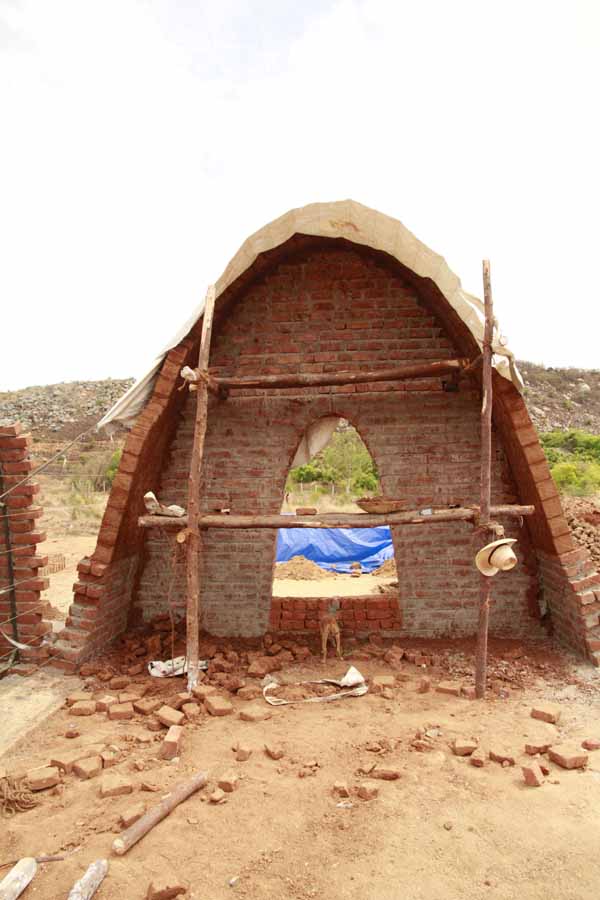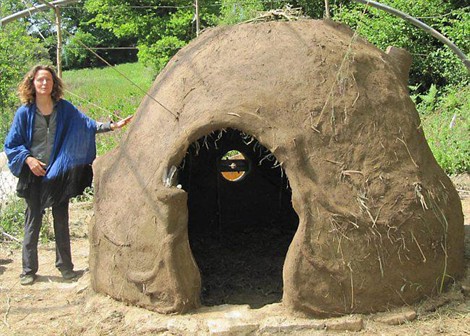Then I wondered - is this even possible? Will it just collapse on me? I started adding framing to support the structure. I gathered the supplies by hand - the straw (I have lots of grass hay straw) and the clay (I have tons of clay) and the water (we had a "rain bomb" of 2 days constant water from ocean heating evaporation global warming).
The idea is to leverage the ecological apocalypse.
The heavy rain drove off the mosquitoes and on the third day, the sun even was out so I got a bit burnt a tiny bit - on the shoulders.
So I just now googled to see if my idea had any leverage. Was there any precedent that I can now follow? YES!
Exhibit 1: Adobe meditation hut.
This is from California - it's too glitzy for me. I just ad hoc throw stuff together - no measurements, etc.
Exhibit 2: Dogon dome adobe house
That actually might not be Dogon but a similar style and it is in Africa. The description does not say where but does say those are a limestone earth tiles on the roof for water proofing. I know historically the lime was also made from wood ash for waterproofing. But what is the support frame?
Now in the West the framing used is either "earth bags" (sand bags) or straw bales - or wood. I would use wood as I have a lot of wood - in a forest.
Exhibit 3: India adobe brick dome vaults:
So here the wood frame is used for actually reaching to the height of the dome and the dome itself is self-supporting. That was my goal or vision but I put too much angle into my bricks! You can see the bricks line up but angle with the support wall.
Check it out - Auroville - the yoga Sri Aurobindo ashram - adobe cobe dome meditation hut.
I never thought of building the support wall out of adobe cob on the inside of the dome - and that would then increase the heat storage! Brilliant!
So that is help right there. Having a "mini-dome" within the support wall - a double vault.
Yes now it is starting to make sense!
Exhibit 4: Argentina: the chimney effect
So this is also the West, of course, and so we can assume it is an earth bag dome or something.
But at least it has a chimney stove pipe, which of course I will need as well.
I need the stove-heater by the door because since it is a "top lit" stove then there can be initial smoke - and so I use a duct pipe that I hold as a chimney effect to light the stove faster. I saw this "trick" on youtube on the Hunter gasification stove I have - and I was skeptical - but then someone in engineering actually did their master's degree on the topic! they studied stoves in Haiti and found using such a "chimney effect" to initially light the stove made it much easier to get going, faster, with no smoke internally.
So I would hold the chimney duct pipe out the door and once the stove was going well enough then put the pot or pan on top that shuts off the top air source and then the actual chimney stove out the roof would kick into effect.
So this is somewhere in California - again most likely an earth bag frame - but a whole village of "tiny dome cabin tents" Exhibit 5: A dome adobe village: how do they get away with it?
The problem is, there’s no building code provision in much of California for cob houses, so most of the legal structures are 120 square feet or less to avoid the requirement for a building permit. Three counties — Nevada, Humboldt and Mendocino — allow cob to be used for dwellings under a state code provision for rural limited density housing.
So here is a whole workshop focused on exactly the concept I have been researching!
Where do you NOT need a building permit to build your tiny house or vacation cabin?
Right - so after I have studied the codes - as long as it is under 150 square feet and an accessory structure - then no permit is needed. Also if it is a tent, then it is not a "structure" and if it is not "permanently attached" (i.e. foundation) it is not a structure.
So that gives me leeway - as I am using the tent for my visual framing for the dome - a dome tent that I'm building around - as the mold. I have a larger tent that can be my main "dwelling site" and this structure then "accessory."
The point being that all my research into whether something is 30 inches tall or not, or "fixed" to the ground, etc. was not just me being paranoid. haha. There are experts on this topic who know where in the U.S. you can build these tiny dome huts without needing a permit!
Exhibit 6: Finally a free standing - no frame!! - adobe hut from Cameroon.
The real deal - no cheating with an "earth bag" frame or wood frame or straw bale frame.
Just pure adobe, self-supporting. And it gets a whole wiki page.
In this method, the mud layers are placed spirally with each lift of about 0.5 m. Each lift is allowed to dry before the next one is added. The walls are thicker at the base, gradually thinning out toward the top, thereby contributing to the structure's stability.[1][2O.K. so this is why I wanted my first layers to dry before I continued the construction process!
I also planned to thin out the adobe as I neared the top. But now I know I need to change the angle of the dome!!
So if I combine the interior support vault from India with this more vertical V dome - then it should be more stable.
http://sustainablebuildingcodes.blogspot.com/ So I had no idea that the whole legal language of "dwelling unit" and "dwelling structure" was codified as an "international residential code"!
That blog writer actually got the code changed so that the minimum room needed is no longer 120 square feet but now just 70 square feet! Thank you!!
My local code again allows "dwelling units" that are NOT "dwelling structures" and this means they are tents. I have it in my email:
So again if you read that blog it states that the "accessory" structure can not be in any way a dwelling unit, even if it is less than 120 square feet (or because of that minimum restriction). The IRC states:"Residential Use" requires a permit if more than one "residential dwelling" is on site.Pits "for extraction of material" are allowed for Forest Agricultural Management use.A "dwelling site" is designated for "residential use" and has tent camping and no "structure" (higher than 30 inches with a fixed location).Since it has no "dwelling unit" (i.e. structure) therefore no land use permit is required.
Structure: "Anything more than 30 inches high placed, constructed or erected with a fixed location on the ground,...."Less than 5 "residential dwellings" are allowed per "residential use" dwelling site and accessory dwellings and structures.An "accessory [residential] dwelling" is a "structure" (that therefore requires a permit) and only one extra "accessory dwelling' is allowed per parcel of land.
"One-story detached accessory structures used as tool and storage sheds, playhouses and similar uses...".O.K. so my composting toilet is in my tent - assuming it is not stolen! haha. And so this tent has an adobe cob foundation around it - not even a foot high yet. So far I am not within the structure definition!
Wow to think I could have "over built" by mistake. I didn't realize this is so touchy - I mean I did being the son of an attorney - but still it is kind of fascinating.
How can I crack this nut?
Exhibit 7: The cracked nut?
So let's review:
1) If it's on a trailer - then you don't need a permit.
But I want to be connected to the Earth to get that yin qi charge up!
2) So then if it is a tent then again no permit. But tents have no real insulation for winter heat.
3) If it is a "structure" then it is a storage or playhouse or similarly...a meditation hut.
Exhibit 8: The dome house ideal?
What kind of framing are they using? Earthbags - adobe earthbags are all the rage now in California!
Wood frame.
And those New Mexico Earthbag buildings?
Some places will allow "experimental" building (New Mexico, for instance)I like this Adobe Cob dog house design! A simple one "Y" wood post in the middle, buried in the ground.












No comments:
Post a Comment